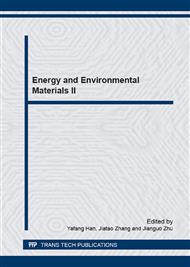p.569
p.574
p.579
p.583
p.590
p.596
p.601
p.607
p.620
Visible-Light Photocatalytic Performance of N/RH/TiO2 Complex Materials
Abstract:
The TiO2 complex samples were produced through sol-gel method, using Ti (OC4H9)4, rice husk (RH) and methenamine as the reactants. Some property analyses were conducted, including X-ray diffraction (XRD), Brunauer-Emmet-Teller (BET), scanning electron microscopy (SEM), Fourier transform infrared spectroscopy (FT-IR), and photocatalytic experiments in the condition of visible-light. The results showed that the size of crystal was limited with the addition of RH in the complex of N/RH/TiO2 samples. The particles of TiO2 were dispersed on the surface of rice husk ash, the skeleton of RH after burning. It can inhibit the phenomenon of agglomerate. The ability of both adsorption and photocatalytie activity of complex samples increased as the surface area increased. Doping N into RH/TiO2 samples can decrease the forming time, inhibit the transformation of crystal from anatase to rutile to some extent, improve the bond of Ti-O-Si to form and make the absorption spectrum move to the red light part. The complex samples exhibited a certain photocatalytic activity under the visible light region. The reaction rate of visible light photodegradation process arrived 0.0143 min-1, meeting with the first-order reaction kinetics.
Info:
Periodical:
Pages:
590-595
Citation:
Online since:
March 2015
Authors:
Keywords:
Price:
Сopyright:
© 2015 Trans Tech Publications Ltd. All Rights Reserved
Share:
Citation:


